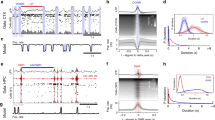Abstract
The mesencephalic reticular formation (MRF) neurons are regarded as contributing to the activation of the cerebral cortex. We have investigated the statistical characteristics of the single neuronal activity in the MRF of cat during two activated states: paradoxical sleep (PS) and state in which the animal is watching birds (BW). 1/f-like spectra are observed for both PS and BW states, being more pronounced for PS state. For the interpretation of these findings, we have applied the clustering Poisson process, which not only gives rise to a 1/f spectrum but also suggests a generation mechanism. The MRF neuronal activities in PS and BW are closely fitted by the clustering Poisson process, both in terms of power spectral density and counting statistics. These results strongly suggest that the activities of MRF neurons in PS and BW can be interpreted as the superpositions of randomly occurring clusters which consist of various number of impulses.
Similar content being viewed by others
References
Ammassian VE, Devito RV (1954) Unit activity in reticular formation and nearby structures. J Neurophysiol 17:575–603
Arques PY (1968)Sur certains problèmes statistiques liés a l'effect de Barkhausen. J Phys 29:369–384
Baiter H-J, Grüneis F, Tilman P (1982) An extended base for the statistical description of cavitation noise. Proceedings of the International Symposium on Cavitation Noise, ASME, Phoenix, Arizona, The American Society of Mechanical Engineering, New York, pp 93–108
Bartlett MS (1963) The spectral analysis of point processes. J R Statist Soc 25:264–296
Blackman RB, Tukey JW (1958) The measurement of the power spectra from the point of view of communication engineering. Dover, Mineola, NY
Cox DR, Lewis PAW (1966) The statistical analysis of series of events. Methuen, London
Grüneis F (1984) A number fluctuation model generating 1/f pattern. Physica 123A:149–160
Grüneis F (1986) Is 1/f noise a doubly stochastic process? In: D'Amico A, Mazzetti P (eds) Noise in physical systems and 1/f noise-1985. Elsevier, Amsterdam New York, pp 369–372
Grüneis F, Baiter H-J (1986) More detailed explication of a number fluctuation model generating 1/f pattern. Physica 136A:432–452
Grüneis F, Musha T (1986) Clustering Poisson process and 1/f noise. Jpn J Appl Phys 25:1504–1509
Lewis PAW (1964) A branching Poisson process model for the analysis of computer failure pattern. J R Statist Soc 29B:343–354
Moruzzi G, Magoun HW (1949) Brain stern reticular formation and activation of the EEG. Electroencephalogr Clin Neurophysiol 1:455–473
Musha T, Higuchi H (1976) The 1/f fluctuation of a traffic current on an expressway. Jpn J Appl Phys 15:1271–1275
Musha T, Higuchi H (1978) Traffic current fluctuation and the Burger's equation. Jpn J Appl Phys 17:811–816
Mushiake H, Kodama T, Shima K, Yamamoto M, Nakahama H (1988) Fluctuations in spontaneous discharge of hippocampal theta cells during sleep-waking states and PCPA-induced Insomnia. J Neurophysiol (in press)
Nakahama H, Suzuki H, Yamamoto M, Aikawa S, Nishioka S (1968) A statistical analysis of spontaneous activity of central single neurons. Physiol Behav 3:745–752
Nakahama H, Ishii N, Yamamoto M, Saito H (1971) Stochastic dependency of neuronal impulse sequences. Tohoku J Exp Med 103:117–118
Nakahama H, Yamamoto M, Ishii N, Fujii H, Aya K (1977) Dependency as a measure to estimate the order and the value of Markov processes. Biol Cybern 25:209–226
Nauta WJH (1958) Hippocampal projections and related neural pathways to the mid-brain in the cat. Brain 81:319–341
Scheibel ME, Scheibel AE (1958) Structural substrates for intégrative patterns in the brain stem reticular core. In: Jasper HH, Proctor LD, Knighton RS, Noshay WC, Costello RT (eds) Reticular formation of the brain. Little Brown, Boston, pp 31–55
Scheibel M, Scheibel A, Mollica A, Moruzzi G (1955) Convergence and interaction of afferent impulses on single units of reticular formation. J Neurophysiol 18:309–341
Steriade M, Sakai K, Jouvet M (1984) Bulbo-thalamic neurons related to thalamortical activation processes during paradoxical sleep. Exp Brain Res 54:463–475
Verne-Jones D (1970) Stochastic models for earthquake occurrence. J R Statist Soc 32B:1–45
Yamamoto M, Nakahama H (1983) Stochastic properties of spontaneous unit discharges in somatosensory cortex and mesencephalic reticular formation during sleep-waking states. J Neurophysiol 49:1182–1198
Yamamoto M, Nakahama H, Shima K, Kodama T, Mushiake H (1986a) Markov-dependency and spectral analysis on spikecounts in mesencephalic reticular neurons during sleep and attentive states. Brain Res 366:279–298
Yamamoto M, Nakahama H, Shima K, Kodama T, Mushiake H (1986b) Time series analysis on single neuronal activities and its applications to sleep physiology. Jpn J Psychiatry Neurol 40:244
Author information
Authors and Affiliations
Rights and permissions
About this article
Cite this article
Grüneis, F., Nakao, M., Yamamoto, M. et al. An interpretation of 1/f fluctuations in neuronal spike trains during dream sleep. Biol. Cybern. 60, 161–169 (1989). https://doi.org/10.1007/BF00207284
Received:
Issue Date:
DOI: https://doi.org/10.1007/BF00207284



